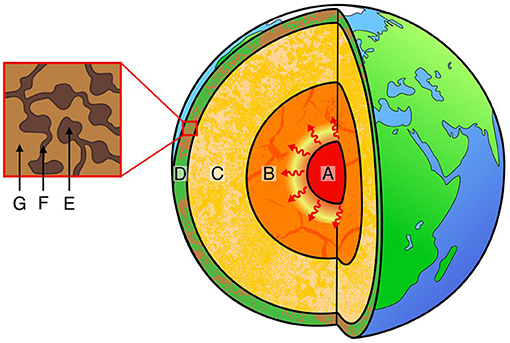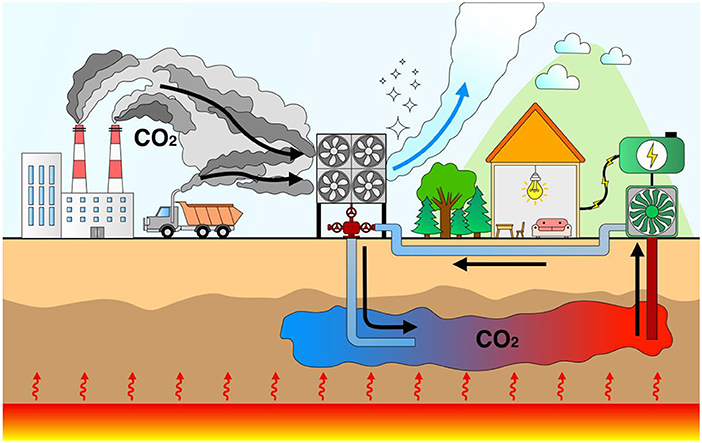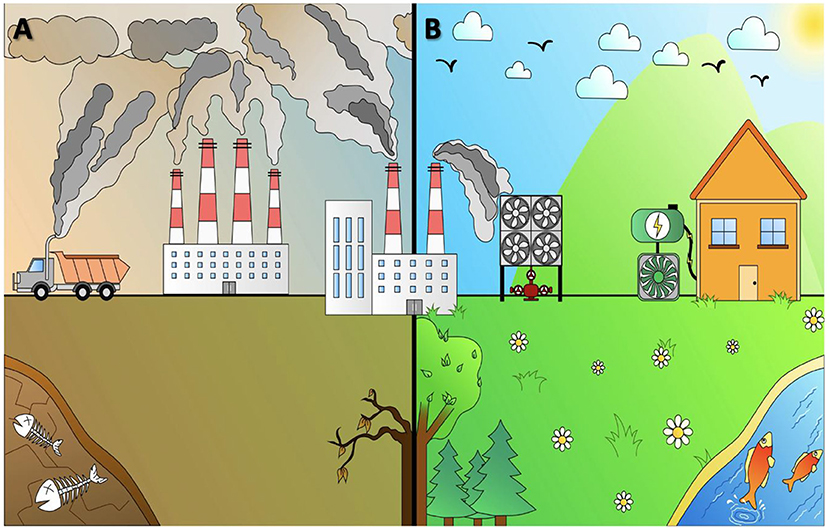Abstract
The United Nation’s Sustainable Development Goal 13–Climate Action (SDG 13) is one of 17 Sustainable Development Goals established by the United Nations General Assembly in 2015. SDG 13 aims to limit climate change and its impacts, ensuring we take action to protect our planet. The biggest cause of climate change is the release of greenhouse gases, in particular carbon dioxide (CO2). CO2 is released into the air when we burn fossil fuels for energy for driving cars, running factories, and generating electricity. So how can we reduce CO2 emissions while ensuring we have the energy we need? In this article, you will learn about a new technology in which CO2 is captured and injected into rocks underground, and then used to create electricity for homes and buildings. By doing this, CO2 can go from being a problem to being part of a solution for climate action.
Watch an interview with the authors of this article to learn even more! (Video 1).
Fighting Climate Change and Protecting our Planet’s Future
In 2015, the United Nations set 17 Sustainable Development Goals (SDGs) to be adopted by all member nations to improve the overall quality of life and protect the environment worldwide. SDG 13–Climate Action is one of these goals. It seeks for all nations to “take urgent action to combat climate change and its impacts”. Thus, SDG 13 wants to help countries prepare for and deal with climate change and the natural disasters that come with a changing climate. SDG 13 has multiple targets to help humans to reduce their carbon dioxide (CO2) emissions by 45% in 2030, and to reach net zero emissions by 2050. These targets include educating people on climate change, raising money to support developing countries in managing the effects of climate change, and ensuring that all countries have plans to protect their populations against climate disasters. SDG 13 is connected to SDG 7 (Affordable and Clean Energy) and SDG 11 (Sustainable Cities and Communities) [1]. To fight climate change, we need to use clean energy and pollute less. Many people still use fossil fuels (e.g., coal, oil, and gas) because they are cheap, but they release a lot of greenhouse gases. If we find affordable clean energy alternatives, fewer people will need to burn fossil fuels, which means cleaner air, less pollution, a healthier environment, and less climate change. But what is climate change and where did it come from?
How We Got Here and Why We Need to Change
For most of our history, humans used simple tools and relied on basic forms of energy like fire and wind. However, around 200 years ago, a major transition happened—the Industrial Revolution. Machines were invented to get work done more efficiently. This led to huge advances for humans, such as technology and transportation. However, these machines operate by burning fossil fuels, which releases CO2 into the atmosphere where it gets trapped and increases Earth’s temperature. This is known as the greenhouse effect. If not reversed, the greenhouse effect will change the climate in undesirable ways, from long-term temperature increases to extreme weather events like hurricanes, droughts, floods, and rising sea levels. We may even see heat waves in the Artic or freezing temperatures in the tropics. Global warming can also cause extinction of some animals and plants.
Science plays a major role in meeting SDG 13. For example, scientists can create climate models based on weather data to predict natural disasters. But the biggest contribution of science is to find new ways to generate clean energy. Scientists now know that decarbonization—reducing the amount of CO2 released into the air—may reverse climate change.
Exploring New Energy Sources
Have you ever wondered what our planet looks like from the inside and what lies deep below your feet? First of all, the Earth is layered. It consists of a very hot core in the center, a mantle surrounding the core, and a thin crust on the surface, where we all live and where valuable treasures like gold, diamonds, oil, and gas can be found (Figure 1). Earth’s crust is made from different types of rocks, which have tiny channels and holes inside, much like an ant hill. While most people pay little attention to what is beneath Earth’s surface, we are exploring how it can help us fight climate change and produce clean energy. You commonly hear about fossil fuel alternatives like solar and wind power, but did you know we have an enormous amount of heat energy waiting to be extracted from deep underground? Rocks deep beneath our feet can provide a solution to our energy needs and reduce CO2 in the atmosphere.

- Figure 1 - (A) At the center of Earth is the inner core, which is extremely hot and solid.
- (B) Surrounding the inner core is the outer core, which is also very hot and helps transfer heat outward because it is liquid. (C) The mantle is a thick layer of rock where heat slowly rises towards the surface. (D) The crust is the thin, solid outer layer where we live. (G) The crust is composed of solid rocks that contain (E) tiny holes, known as pores, and (F) connecting channels, known as throats. Pores and throats are filled with water, oil, or gasses.
Scientists are developing solutions to capture CO2 from the air and store it safely underground, removing harmful emissions effectively and permanently. The tiny pores and channels in the rocks of Earth’s crust may be even smaller than the thickness of a hair, but there are billions of them. Combined, they make an enormous volume of space, so large that all the CO2 released by industry could easily fit inside [2]. Thus, we could inject CO2 deep underground into these pores and trap it in a way that prevents it from escaping back to the surface.
But how will this CO2 produce energy? Imagine Earth like a baked potato, filled with molten hot butter at its core and wrapped in aluminum foil (Earth’s crust). The temperature in the core is not precisely known but believed to be around 6,000°C. This is 30 times hotter than the highest temperature of your kitchen oven [3]! Of course, the temperature is lower towards the Earth’s crust. Still, this heat can be harvested from the hot rocks using fluids (typically water) and transported to the surface as a renewable energy source called geothermal energy.
Scientists have proposed a new technology called CO2-plume geothermal (CPG), in which CO2 stored underground is transported back to the surface to extract Earth’s heat and generate electricity.
From Problem to Solution
Our research at KAUST studies how CPG can be made affordable. This approach pumps CO2 underground through the deep holes into hot rocks, where temperatures can reach 150–250°C [4]. The CO2 will heat up as it moves through the rock pores and channels. It then reaches another hole that pumps it back to the surface as a hot fluid. We extract that heat as geothermal energy to produce electricity, which can be sold. The cooled CO2 goes back underground, and the cycle starts all over again (Figure 2). This is a great approach because one of the biggest challenges of storing CO2 underground is the high cost of drilling deep holes. But using this dual-purpose method, we can reduce the costs of CO2 storage by generating clean energy that can be sold!

- Figure 2 - The CPG process captures CO2 and turns it into a liquid to generate geothermal energy.
- Several holes, called wells, are drilled several km deep into Earth’s subsurface. An injector well pumps cold CO2 down (blue well), where hot rocks heat it up. Then, a producer well (red well) transports the CO2 back to surface, carrying the energy in form of heat. This heat is extracted to generate electricity to power homes. After heat extraction, the cold CO2 is re-injected underground. Once a reservoir is filled with CO2, the system continues to produce geothermal heat and generates electricity through continued CO2 circulation.
For CPG to work, selecting the right underground location and understanding how CO2 flows underground is essential. Our team’s research at KAUST showed that it is possible to use CO2 in this dual-purpose way. By using this method, we remove CO2 from the atmosphere and create a cost-effective way to fight climate change and support a clean-energy future (Figure 3) [5].

- Figure 3 - (A) A world where we release a lot of pollution, including CO2, into the air without capturing it.
- As a result, climate change makes trees and animals struggle, and the environment suffers. (B) A cleaner world, where we capture CO2 before it harms the planet. This captured CO2 helps generate renewable energy and keeps the air clean, allowing plants, animals, and people to live healthier lives.
For our study location, CPG could generate an average of about 164 megawatts of power every year [5]. This is enough electricity to power thousands of homes every day, or the equivalent of about 2,300 electric cars! Furthermore, we calculated that this clean energy system is price competitive: it could produce electricity at an average cost of about $77 per megawatt-hour—cheaper than electricity from nuclear energy and about the same as wind power, solar power, or pumped hydropower [5].
Another exciting aspect is how much CO2 this method can store. CPG systems could hold around 1.15 gigatons of CO2 over 11.5 years [5]. This is approximately equal to the emissions from 230 million cars in 1 year. If you lined up all those cars, they would circle the Earth almost 30 times! Safely storing this much CO2 underground would be a game changer for fighting climate change. Hopefully, our geologists can find many places underground to store and use CO2 in this way.
To Sum it Up
In this article, you learned that energy is vital for our society, but that we are relying on sources that are bad for the environment because they cause climate change. SDG 13 aims to find clean energy sources to reduce the buildup of CO2 in our atmosphere. By capturing CO2 and injecting it into hot rocks underground, we transform this harmful gas into a source of renewable energy. This dual-purpose approach reduces global warming and at the same time supports a sustainable energy future. CO2 becomes part of the solution instead of just being a problem. However, while this is a big step forward, more work is needed to put this method within reach. Also, geothermal energy should not be the only renewable energy source we use in the future—we need all available solutions to tackle climate change. In fact, you can do your part! You can support SDG 13 by saving energy in your house or school (like by turning off the lights when they are not needed), learning and teaching others about climate change, and encouraging your community to use renewable energy sources. Even small actions can help create a healthier planet!
Glossary
Carbon Dioxide (CO2): ↑ A gas released by burning fossil fuels. It traps heat in the atmosphere, causing Earth to warm up and leading to climate change.
Net Zero: ↑ A state in which the greenhouse gases going into the atmosphere are balanced by removal of gases out of the atmosphere.
Clean Energy: ↑ Clean energy is energy that comes from renewable, zero emission sources that do not pollute the atmosphere when used, as well as energy saved by energy efficiency measures.
Fossil Fuels: ↑ Natural fuels such as coal, oil, or gas, formed over millions of years underground from the remains of dead organisms and plants.
Greenhouse Gases (GHGs): ↑ Gases in the atmosphere that trap heat and thus raise Earth’s surface temperature.
Decarbonization: ↑ The process of reducing the amount of CO2 released into the air, often by using clean energy sources and capturing some of the emitted CO2.
Geothermal Energy: ↑ Energy created from the natural heat stored inside the Earth. It is a clean and renewable source of power.
CO2-plume Geothermal (CPG): ↑ A method that uses CO2 to create clean energy by heating it in underground hot rocks and using it to generate electricity.
Conflict of Interest
The authors declare that the research was conducted in the absence of any commercial or financial relationships that could be construed as a potential conflict of interest.
Acknowledgments
We would like to thank Ruben Costa and Nicki Talbot at KAUST for their invaluable support during the initial writing stage and review process, without which this collection would not have been possible. We also extend our gratitude to the KAUST Office of Sustainability and the UNDP Saudi Arabia Country Office for their dedication to raising awareness of the UN SDGs in our journey toward a more sustainable world.
AI Tool Statement
Any alternative text (alt text) provided alongside figures in this article has been generated by Frontiers with the support of artificial intelligence and reasonable efforts have been made to ensure accuracy, including review by the authors wherever possible. If you identify any issues, please contact us.
References
[1] ↑ Ross, J. (ed.) 2023. The Sustainable Development Goals Report: Special Edition Towards a Rescue Plan for People and Planet. New York, NY: United Nations, Department of Economic and Social Affairs Statistics Division.
[2] ↑ Basilio, E., Addassi, M., Al-Juaied, M., Hassanizadeh, S. M., and Hoteit, H. 2024. Improved pressure decay method for measuring CO2-water diffusion coefficient without convection interference. Adv. Water Resour. 183:104608. doi: 10.1016/j.advwatres.2023.104608
[3] ↑ Lowrie, W. 2007. Fundamentals of Geophysics, 2nd Edn. Cambridge: Cambridge University Press. doi: 10.1017/CBO9780511807107
[4] ↑ Boden, D. R. 2016. Geologic Fundamentals of Geothermal Energy. Boca Raton, FL: CRC Press. doi: 10.1201/9781315371436
[5] ↑ Ezekiel, J., Vahrenkamp, V., Hoteit, H. A., Finkbeiner, T., and Mai, P. M. 2024. Techno-economic assessment of large-scale sedimentary basin stored–CO2 geothermal power generation. Appl. Energy 376:124270. doi: 10.1016/j.apenergy.2024.124270
